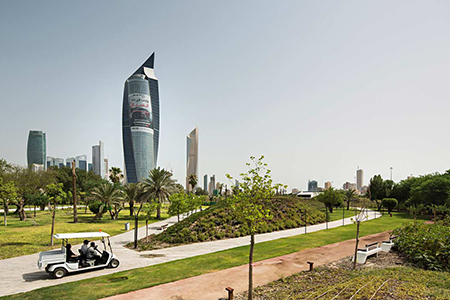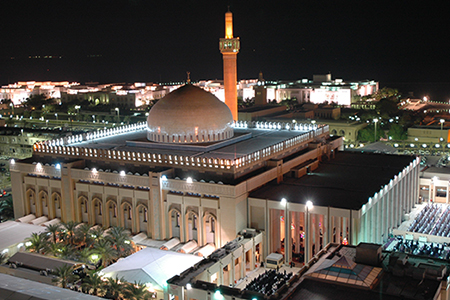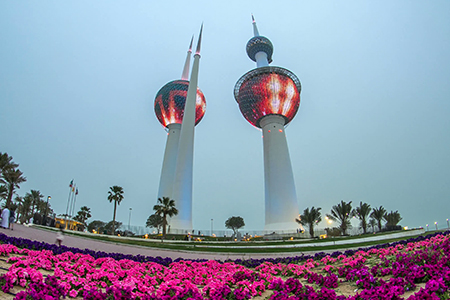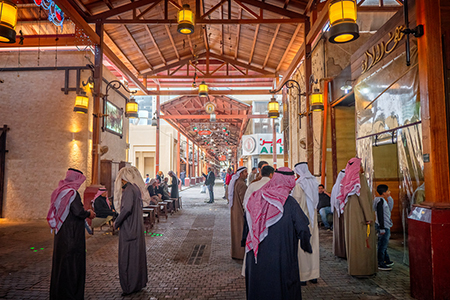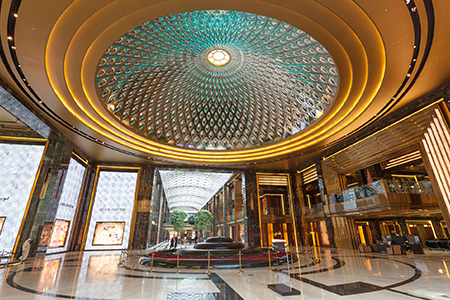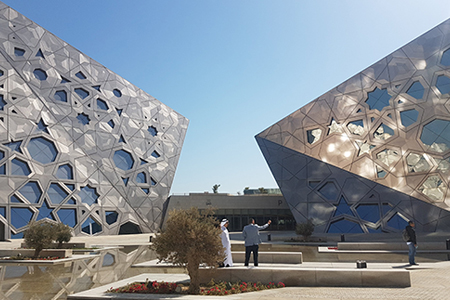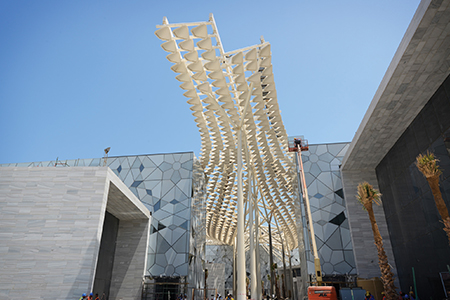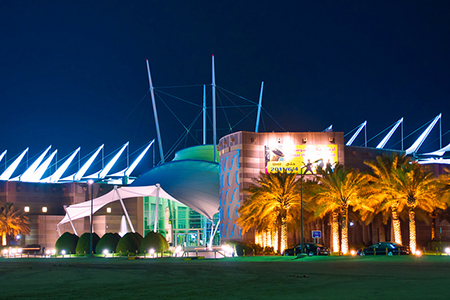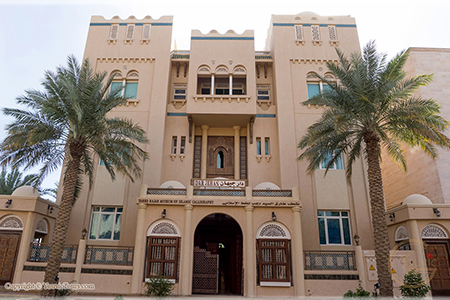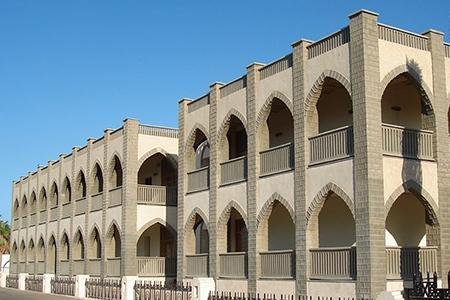About Kuwait
The State of Kuwait is an Arab country located at the tip of the Arabian Gulf, with a population of 4.2 million people. Kuwait City, the capital, is known for its modern architecture, ranging from skyscrapers to the striking Kuwait Towers, water towers whose design recalls the tiled domes of a classic mosque.
Al Shaheed Park
Al Shaheed Park is the largest urban park in Kuwait.
Al Shaheed Park is a fully integrated cultural platform with cutting-edge architecture and art works. The park's Amphitheater diversifies into different kinds of gardens (Oasis Garden, Museum Garden, Seasonal Garden and others), walkways (Visitors and Pedestrian Passages), museums, exhibition areas, outdoor theatres, and performance centers for music concerts, theatrical performances, art exhibitions, and other kinds of cultural events. Al Shaheed Park consists of several phases. Phase II of the park opened in April 2017. The new phase includes a skate park, parkour area, tree top climbing obstacles, multipurpose youth complex, board and interactive games area, and an open air performance centre.
Al Shaheed Park landscapes also hold multiple historical zones such as the Memorial zone and the Museum zone. The park is part of the new Kuwait National Cultural District (KNCD).
Grand Mosque
The Grand Mosque is the largest and the official mosque in the country of Kuwait. Its area spans 45,000 square metres (480,000 sq ft), out of which the building itself covers 20,000 square metres (220,000 sq ft). The main prayer hall is 72 metres (236 ft) wide on all sides, has teakwood doors, and has lighting provided by 144 windows.
The dome of the mosque is 26 metres (85 ft) in diameter and 43 metres (141 ft) high, and is decorated with the Asma al-Husna, the 99 names of God. The mosque can accommodate up to 10,000 men in the main prayer hall, and up to 950 women in the separate hall for women. The mosque also contains a 350 square metres (3,800 sq ft) library of Islamic reference books and documents. To accommodate the large number of vehicles belonging to worshippers, the mosque also contains a 5-level car park underneath the eastern courtyard which can hold up to 550 cars. Construction on the mosque started in 1979, and the mosque was completed in 1986, first of Shawwaal in 1407, or Eid ul-Fitr. The mosque's minaret, located at the northwest corner, resembles Andalusian architecture.
Kuwait Towers
The Kuwait Towers are a group of three slender towers in Kuwait City, standing on a promontory into the Persian Gulf. They were the sixth, and last, group in the larger Kuwait Water Towers system of 34 towers (33 store water; one stores equipment), and were built in a style considerably different from the other five groups. The Kuwait Towers were officially inaugurated in March 1979 and are regarded as a landmark and symbol of modern Kuwait. The towers were closed for maintenance from March 2012 to 8 March 2016, with a massive fireworks festival commemorating the re-opening.
In 1980, the Kuwait Water Towers system, including the Kuwait Towers, was an inaugural recipient of the Aga Khan Award for Architecture.
Design and Construction
The main tower is 187 metres (614 ft) high and carries two spheres. The lower sphere holds in its bottom half a water tank of 4,500 cubic metres (1,200,000 US gal; 990,000 imp gal) and in its upper half there is a restaurant that accommodates 90 people, a café, a lounge and a reception hall. The upper sphere, which rises to 123 metres (404 ft) above sea level and completes a full turn every 30 minutes, holds a café. The second tower is 147 metres (482 ft) high and serves as a water tower. The third tower does not store water, housing equipment to illuminate the two larger towers. The two water towers hold 9,000 cubic metres (2,400,000 US gal; 2,000,000 imp gal) of water altogether. Although there are three towers, the structure is often referred to as Kuwait Tower in singular.
The Kuwait Towers were designed by Danish architect Malene Bjørn as part of a water distribution project run by the Swedish engineering company VBB (renamed Sweco in 1997). Chief architect of the company and husband of Malene Bjørn, Sune Lindström, erected five groups of his typical "mushroom" water towers, the Kuwait Water Towers, but the Emir of Kuwait, Sheikh Jaber Al-Ahmed, wanted a more attractive design for the sixth site. Out of ten different designs, three were presented to the Amir, who chose the design built.
VBB contracted construction of the three Kuwait Towers to Energoprojekt of Belgrade, Yugoslavia (now part of Serbia). The towers were built of reinforced concrete and prestressed concrete. Building took place from 1971 to 1976 and the main tower was opened to the public on 1 March 1979.
Approximately 41,000 enameled steel discs cover the three spheres in eight shades of blue, green and gray, recalling the tiled domes of historic mosques. The discs are arranged in spiral patterns around the spheres. According to the architect, the Kuwait Tower group refers to ideals of humanity and technology, symbolised by the globe and the rocket.
Souq Al Mubarakeya
Souq Al-Mubarakiya is a souq in Kuwait City, Kuwait. It is one of the oldest souqs in Kuwait, and was the center of trade prior to the discovery of oil.
This popular traditional market is located in Kuwait City, between Abdullah Al-Mubarak, Abdullah Al-Salem & Palestine Streets.This market has been around for at least 200 years. The market was damaged during the Iraqi invasion in 1990, however it was renovated and it got back its traditional flavor.
You can spend hours in this market strolling around and discovering reasonable bargains on heritage goods such as Persian silk carpets, real Arab antiques, perfumes like musk and oud, and traditional costumes. This place is perfect whether you want to shop, eat, or for sightseeing. Al-Mubarakiya features a variety of shops such as dates, honey, spices, sweets, vegetables, fruits, meat, and fish. In addition to a range of shops accessories, gold and silver jewelries. The market also hosts two mini museums: Sheikh Mubarak Kiosk and the first Islamic pharmacy in Kuwait, and admission is free.
There is a courtyard near Al-Bahar or Sea Mosque, where you can find traditional cafes brewing their teas over coals, and several small restaurants are lined-up where they serve authentic Arabic, Indian, Persian food to the customers in the open air. The prices are the cheapest in Kuwait. On hot summer days, water mist is sprayed from pipes over the tables to give you a cooling feeling. A children playground is nearby and shisha is also available.
The Avenues
The Avenues Mall is the largest shopping mall in Kuwait and the second largest mall in the Middle East. The mall is located in the Rai area extending from Fifth Ring Road from the south and Al Ghazali Highway from the east. It opened in April 2007, under the patronage of the Amir of Kuwait Sheikh Sabah Al Ahmed Al Sabah. It was the winner of the ICSC Gold Award for “Best Shopping Center 2013” under the Expansion and Design Category in the Middle East & North Africa. It features more than 800 stores and parking space that fits more than 10,000 cars.[3] Its exteriors are surrounded by fountains.
Currently, the 4th phase of the mall is being constructed and is expected to be inaugurated by 1st quarter of 2018. The 4th phase includes expansions to existing districts as well as new districts, namely, The Arcades, The Grand Plaza, The Forum, The Gardens, Electra and The Cinema; as well as a five-star hotel and another four-star hotel, which will cover an area of 117,000 sq.m. There will be an increase in the number of stores from 800 to 1,100.
The shopping mall has four distinct phases: Phase I having been complete in December 2006, Phase IIA in May 2008, Phase IIB in August 2009, Phase III in November 2013 and Phase IV in March 2018. Across a span of twelve years, The Avenues has spent a total of 3,061,500,000 USD (3.06 billion United States Dollars) in building and constructing the shopping mall. The Avenues is home to a number of districts: 1st Avenue, 2nd Avenue, Grand Avenue, Prestige, The Mall, SOKU, The Souk, The Arcades, The Cinema, The Gardens, Electra and Grand Plaza. The latter five opening as a part of the new extension of Phase IV.
360 Mall
360 Mall is a luxury shopping mall in Al Zahra area, Kuwait. It can be reached by using the sixth ring road. It is the third biggest mall in Kuwait.
The 360Mall derives its name from its circular structure, which was due in part to the rigorous zoning restrictions. It is located in one of Kuwaitas fastest growing residential areas. It is influenced by Middle Eastern architecture, featuring hand-blown glass sculptures by Dale Chihuly, along with a Solar Garden with 21,000 plants growing on a vertical wall intended to help improve air quality and act as a natural bio-filter. Other features include a water feature, an organically shaped skylight in the Main Atrium, and sculptured landscaping on the outside of the building.
The mall includes the first Géant Casino hypermarket in Kuwait, a Marks & Spencer department store, and leisure and entertainment areas.
Sheikh Jaber Al Ahmad Cultural Centre
The Sheikh Jaber Al-Ahmad Cultural Centre (JACC), informally known as the Kuwait Opera House, is a prominent cultural center in Kuwait, located on the Gulf Road in the capital Kuwait City. It is the largest cultural center and opera house in the Middle East. The cultural centre is part of the new Kuwait National Cultural District (KNCD).
The Sheikh Jaber Al-Ahmad Cultural Centre is a multidisciplinary public space owned by the Amiri Diwan striving to entertain, educate and inspire the people of Kuwait. It offers a range of events - in music, theatre, film, workshops and spoken word - for every generation and sector of society. JACC provides a space for dialogue to share and showcase skills and knowledge, giving younger voices a forum in which to speak. The cultural centre is a platform for educational and cultural exchange; moreover, it functions as an influential entertainment and culture powerhouse and productive space for the region.
The cultural complex, which includes theatres, concert halls, music centres, conference and exhibition halls, cinemas, libraries, center for historical documents, and public park, took two years to complete. It is 214000 m² in size and had a budget of US$775 million.
Sheikh Abdullah Al Salem Cultural Centre
The Sheikh Abdullah Al-Salem Cultural Centre is a cultural complex in Kuwait owned by the Diwan Amiri. It consists of museums, fine arts centre, theatre, and public spaces that include outdoor exhibits, as well as cafes and restaurants. The Sheikh Abdullah Al-Salem Cultural Centre is a 13-hectare site with a total exhibit area of 22,000 m2 making it the largest museum project in the world.
The Sheikh Abdullah Al Salem Cultural Centre will create a new world class museum district within Kuwait. Together with the Sheikh Jaber Al Ahmad Cultural Centre, the cultural centre is part of the new Kuwait National Cultural District (KNCD).
The cultural district is a celebration of the scientific and cultural achievements of mankind and the scale, shapes and shades of the buildings are designed to convey a sense of wonder and awe.
Each building contains an array of permanent and temporary world class exhibits and artworks. Kuwaiti architecture is represented by the main ‘street’ which is not a straight line and echoes the traditional ‘Ferej’. This creates exciting spaces, corners and walkways, mirroring the experience of walking down a traditional, busy Kuwaiti street.
The museums present Kuwaiti, Islamic, and Arab culture and history. They also embrace and showcase the rich diversity of the world’s finest cultural achievements.
The museum district consists of six main buildings:
- Space Museum
- Science Museum
- Natural History Museum
- Arabic Islamic Science Museum
- Fine Arts Centre
- Theatre
The fine arts centre includes artist studios and an artist-in-residence program.
Failaka Island
Failaka Island is a Kuwaiti Island in the Persian Gulf. The island is 20 km off the coast of Kuwait City in the Persian Gulf. The name "Failaka" is thought to be derived from the ancient Greek fylakio(n) "outpost".
In 2000 B.C., Mesopotamians settled in Failaka at least a century before the Dilmun civilization. Traders from the Sumerian city of Ur occupied Failaka and ran a mercantile business. Failaka had many Mesopotamian-style buildings typical of those found in Iraq dating from around 2000 B.C.
Starting in the 3rd millennium BC, Failaka belonged to the Dilmun civilization. During the Dilmun era (from ca. 3000 BC), Failaka was known as "Agarum", the land of Enzak, a great god in the Dilmun civilization according to Sumerian cuneiform texts found on the island. As part of Dilmun, Failaka became a hub for the civilization from the end of the 3rd to the middle of the 1st millennium BC. Failaka was settled following 2000 BC after a drop in sea level.
After the Dilmun civilization, Failaka was inhabited by the Kassites of Mesopotamia, and was formally under the control of the Kassite dynasty of Babylon. Studies indicate traces of human settlement can be found on Failaka dating back to as early as the end of the 3rd millennium BC, and extending until the 20th century AD. Many of the artifacts found in Falaika are linked to Mesopotamian civilizations and seem to show that Failaka was gradually drawn toward the civilization based in Antioch.
Kuwait Scientific Center
The Scientific Center of Kuwait, located in Salmiya, Kuwait, serves as a center for environmental education of the Persian Gulf. KSC spans over 80,000 square meters with the building covering over 18,000 square meters. The center also houses the largest aquarium in the Middle East after Dubai, holding over 100 different species of animals. Along with the aquarium, it also contains an IMAX theatre, a harbor of historic dhows, and a gift shop among other contents.
The Scientific Center, as it is locally referred to, is home to one of the largest aquariums in the Persian Gulf region with the capacity of one of the tanks at 1.5 million liters. It also has coffee shops and a food court along with a walkway that shows the more scenic views of the coastline of Kuwait. The center also attracts hundreds of students each year on field trips, organized by schools and the Scientific Center. The aim of the Scientific Center is to spread awareness to the people of Kuwait and visitors alike about the different ecosystems of the region as well as the history of the country, while also encouraging the preservation of said goals.
The building enclosure is filled with designs of Arabic calligraphy as well as Islamic art. Along with this, the walls literally have the history of Kuwait written on them. Its architecture is inspired by both the "old" mud-homes of Kuwait and the sail of a ship. The mud-home correlation is seen as the mud-colored ceramic used on the exterior of the building, while the mast is the top "roof" part of the building which is made of fabric similar to that of the sails of dhows, which are an important part of Kuwaiti history of pearl diving. The colors chosen were meant to create the atmosphere of the "desert" both inside and out, with the inside continuing on the theme of Kuwait's heritage and culture, built into the walls of the Scientific Center.
Tareq Rajab Museum of Islamic Calligraphy
Tareq Rajab Museum is a museum in Kuwait. The Tareq Rajab Museum houses a collection of over thirty thousand items collected over the last fifty years, of which approximately ten thousand are on permanent display.
The museum is divided into two parts: in Area A, calligraphy, manuscripts, miniatures, ceramics, metalwork, glass, jade-, wood- and stone-carvings are exhibited. Area B contains objects which were produced in the Islamic world during the last ca. 250 years, i.e. costumes, textiles, jewellery and musical instruments.
The Tareq Rajab Museum's pottery collection is very large and comprehensive, including vessels from pre-Islamic times right up to the first part of the 20th century. The earliest vessels date from the late Parthian - early Sasanian periods, while the latest ones are from Palestine, made in the 1930s.
The Tareq Rajab Museum is considered the leading museum specialising in Silver Folk jewellery; it houses around 12,000 pieces in which only 2,000 are on display. The museum also has a very fine and rare collection of gold jewellery. In the Gold Room the displays go as far back as the pre Islamic period and are mainly from the Middle East although there is a section on non Islamic, Roman and Byzantine that shows the links with the Islamic Ornaments.
The Tareq Rajab Museum in Kuwait has a large and important collection of Al Qur'an and manuscripts from all periods and countries (including NW China) around the Islamic world. The museum possesses some fine examples of the writings of renowned calligraphers such as Yaqut Al Musta’simi (died 1293). Although little of his work has survived, his influence was of outstanding importance to the development of calligraphy.
In contrast to the top-down approach in other Gulf states, museum development in Kuwait reflects a greater sense of civic identity and demonstrates the strength of civil society in Kuwait, which has produced many independent cultural enterprises.
Amricani Cultural Centre
Dar al Athar al Islamiyyah is a cultural organization operating several cultural centers in Kuwait. The organization has a collection of more than 20,000 items of rare Islamic art. The collection belongs to Sheikh Nasser Sabah Al-Ahmed Al-Sabah and his wife Sheikha Hussa Sabah Al-Salem Al-Sabah, who personally overseess the museum. Many items, especially those from the pre-Islamic period, are housed at Amricani Cultural Centre in Kuwait.
The Dar al Athar al Islamiyyah cultural centres include education wings, conservation labs, and research libraries.



